|
There are too many
guys out there who only train what they can see in a mirror: Biceps, pecs, abs,
and even quads. They train them hard with total dedication. They dont mind
rolling up a sleeve to flash a BI or pulling up their shirt to flash the ABS, but dont ever tell them to turn
around. After a good warmup and
stretch consisting of chins and pullups, lets begin with seated rows.
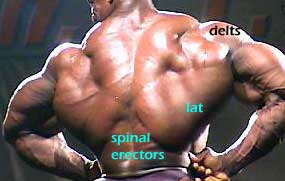 delt -
deltoids - raise the arm to the front, side and back. delt -
deltoids - raise the arm to the front, side and back.
lat - Latissimus
dorsi - a very large muscle which lowers the arms to the
side.
spinal
erector - helps keep the upper body stable - raises the back
from a 'bent over' position. |
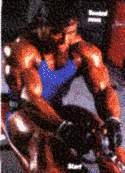 The
seated
row exercise is excellent for building thickness in the back and lower lats. You
want to feel your lats stretch and feel your back muscles doing most of the work. With you knees
bent, extend the arms all the way forward; Then, pull the
weights back and and into the abs while ensuring the upper body is angled
slightly back. While in this position, flex the lats and all the muscles
in the entire back. Repeat this for every set you do. You should do the typical
4 sets with 8 to 10 reps per set routine with moderate to heavy weight. There
are different variations to this exercise. You can do these with the weight in
the overhead position the where the weight is brought down to the center of the
chest. Another variation is where the weight is below your center of gravity and
it is pulled to the ab section. Either way, the exercises should be performed
the same way. Another way to maximize this benefits of this exercise is to use
either straps or hooks to take the pressure off of the biceps and to isolate the
back muscles. A much more intense back workout will be achieved if you dont lose
your ability peform well due to your biceps being over worked. The second
exercise in this routine is the one arm dumbell rows. The
seated
row exercise is excellent for building thickness in the back and lower lats. You
want to feel your lats stretch and feel your back muscles doing most of the work. With you knees
bent, extend the arms all the way forward; Then, pull the
weights back and and into the abs while ensuring the upper body is angled
slightly back. While in this position, flex the lats and all the muscles
in the entire back. Repeat this for every set you do. You should do the typical
4 sets with 8 to 10 reps per set routine with moderate to heavy weight. There
are different variations to this exercise. You can do these with the weight in
the overhead position the where the weight is brought down to the center of the
chest. Another variation is where the weight is below your center of gravity and
it is pulled to the ab section. Either way, the exercises should be performed
the same way. Another way to maximize this benefits of this exercise is to use
either straps or hooks to take the pressure off of the biceps and to isolate the
back muscles. A much more intense back workout will be achieved if you dont lose
your ability peform well due to your biceps being over worked. The second
exercise in this routine is the one arm dumbell rows. |
 The
one
arm dumbell row is done with one knee on the bench and the other foot planted
securely on the floor. Although many people have their own preferences in their
body position when doing this exercise, and the picture depicts different, its
best to have the weight in one hand and position the other hand firmly on the
bench so that you are almost in a tripod position. For example, if you
are holding the weight in the right hand, you want to have your left knee and
left hand on the bench and your right foot planted on the floor and vice versa
for the weights being in the left hand. When lowering the weight, let it hang
for a second or two two really stretch the lats. When bringing the weight upward, bring it straight up and not angled and make sure you flex the
lats at the climax of the rep. You should repeat this for every rep. Again, try
to do 4 sets of these with 8 to 10 reps per set. Its ok to go heavy when doing
these but you must remember that form is extremely important; You want to ensure
that you get a full range of movement. If you can use heavier weights and still
maintain correct form by all means do it, but if you find yourself not getting a
full range of motion (half reps), try a lower weight. Also with this exercise,
it is beneficial to use straps and hooks to isolate the back and lats and to
save wear and tear on the arms. The next exercise described in my routine is the
pulldown. The
one
arm dumbell row is done with one knee on the bench and the other foot planted
securely on the floor. Although many people have their own preferences in their
body position when doing this exercise, and the picture depicts different, its
best to have the weight in one hand and position the other hand firmly on the
bench so that you are almost in a tripod position. For example, if you
are holding the weight in the right hand, you want to have your left knee and
left hand on the bench and your right foot planted on the floor and vice versa
for the weights being in the left hand. When lowering the weight, let it hang
for a second or two two really stretch the lats. When bringing the weight upward, bring it straight up and not angled and make sure you flex the
lats at the climax of the rep. You should repeat this for every rep. Again, try
to do 4 sets of these with 8 to 10 reps per set. Its ok to go heavy when doing
these but you must remember that form is extremely important; You want to ensure
that you get a full range of movement. If you can use heavier weights and still
maintain correct form by all means do it, but if you find yourself not getting a
full range of motion (half reps), try a lower weight. Also with this exercise,
it is beneficial to use straps and hooks to isolate the back and lats and to
save wear and tear on the arms. The next exercise described in my routine is the
pulldown. |
 When
doing the lat-pulldown
exercise, grab the angled portions of the bar using a
slightly wider than shoulder-width grip. Position yourself on the pulldown
machine so that te middle parts of the thighs fit under the leg restraint. Pull
the bar down to the center of your chest, leaning back somewhat as you perform
the movement. While the bar is against the chest, Flex the back muscles. Do this
for every rep. Focus on the action of your back muscles, using your arms only as
connecting rods between the bar and your back. When bringing the bar behind the
neck, bring the bar to the back of the neck and pause for one second, and give
resistence when letting the weight back up. When doing this exercise to the rear, try not to do extremely heavy weights because this puts an enormous strain
on the rotator cuffs and the muscles of the shoulder. A variation to this
exercise is to grab the bar with the palms facing you (chin-up position). In
this position the arms can be placed closer together to work the upper lats
more, or they can be placed farther apart for the lower lats. Either way, I
would incorporate these into my back workout. Again, the use of straps or hooks
will enhance the back workout. Try to do 4 sets of these with 8 to 10 reps per
set. If you find yourself not completing full reps or find youself jerking the
weights down, try to lessen the weight so the form is correct. When
doing the lat-pulldown
exercise, grab the angled portions of the bar using a
slightly wider than shoulder-width grip. Position yourself on the pulldown
machine so that te middle parts of the thighs fit under the leg restraint. Pull
the bar down to the center of your chest, leaning back somewhat as you perform
the movement. While the bar is against the chest, Flex the back muscles. Do this
for every rep. Focus on the action of your back muscles, using your arms only as
connecting rods between the bar and your back. When bringing the bar behind the
neck, bring the bar to the back of the neck and pause for one second, and give
resistence when letting the weight back up. When doing this exercise to the rear, try not to do extremely heavy weights because this puts an enormous strain
on the rotator cuffs and the muscles of the shoulder. A variation to this
exercise is to grab the bar with the palms facing you (chin-up position). In
this position the arms can be placed closer together to work the upper lats
more, or they can be placed farther apart for the lower lats. Either way, I
would incorporate these into my back workout. Again, the use of straps or hooks
will enhance the back workout. Try to do 4 sets of these with 8 to 10 reps per
set. If you find yourself not completing full reps or find youself jerking the
weights down, try to lessen the weight so the form is correct.
|
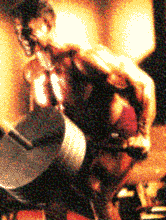 The
standing bent-over row (T-BAR)
exercise is an excellent overall muscle
developer for the back. There are about 3 different ways to grips to do
this exercise. The one we'll discuss is the handle-bar grip. Grab the handles
out near the bend in the bar, and while bending the knees to minimize
unneccessary stress on the lower back, pull the bar to your chest and hold this
position for a split second to flex the back muscles, then slowly lower it.
Because the T-bar weight is loaded in the front of the machine, the size of the
45 pound plates can actually limit the range of motion (the plates may hit the
chest not allowing to raise high enough to work the back). Because of this, it
may be necessary to use 25lb weights. You want to keep your back arched and
knees bent when executing the reps. On the bottom portion of the rep you can
round your back slightly for a little extra stretch. You can maintain the same
grip for each set or you can do each set with a different grip. Experiment to
see what works best for you. Again, you want to do 4 sets with 8 to 10 reps per
set. You can use heavy weight for this exercise if your form isn't sacrificed.
Straps or hooks can also enhance the usefulness of this exercise. The
standing bent-over row (T-BAR)
exercise is an excellent overall muscle
developer for the back. There are about 3 different ways to grips to do
this exercise. The one we'll discuss is the handle-bar grip. Grab the handles
out near the bend in the bar, and while bending the knees to minimize
unneccessary stress on the lower back, pull the bar to your chest and hold this
position for a split second to flex the back muscles, then slowly lower it.
Because the T-bar weight is loaded in the front of the machine, the size of the
45 pound plates can actually limit the range of motion (the plates may hit the
chest not allowing to raise high enough to work the back). Because of this, it
may be necessary to use 25lb weights. You want to keep your back arched and
knees bent when executing the reps. On the bottom portion of the rep you can
round your back slightly for a little extra stretch. You can maintain the same
grip for each set or you can do each set with a different grip. Experiment to
see what works best for you. Again, you want to do 4 sets with 8 to 10 reps per
set. You can use heavy weight for this exercise if your form isn't sacrificed.
Straps or hooks can also enhance the usefulness of this exercise.
Building the back is probably the most difficult of all muscle groups.
Its also probably takes the longest of all muscle groups to build also. Don't
get discouraged if your back takes longer than the other groups, just stick with
it.
|
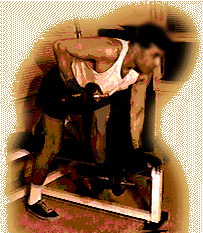 |
Sweat That Back!
Each set consists of eight repetitions. To
warm up: Do a set at fifty percent of your maximum effort. Begin with
three sets of eight. When you can't break a sweat with that, add five more
reps to each set.
Seated row.
You need a multistation gym for this one. Sit on the floor in front of the
low pulley bar. With your knees bent a little, reach out and grab the
pulley bar with both hands. Pull it slowly to your chest, keeping your
back straight and - as much as possible - perpendicular to the floor
throughout the movement.
Lat pulldown.
Grasp the lat pulldown bar with your hands slightly more than
shoulder-width apart. Sit down and wedge your knees under the kneepads.
Lower the bar until it touches the front of your upper chest. Don't lean
back more than a few inches.
Reverse,
close-grip pulldown. Grasp the lat pulldown bar with your palms
facing you and your hands about eight inches apart. Keeping your back
straight, lower the bar until it touches the top of your chest.
<< One-arm
dumbbell row. Rest your left hand and left knee on an exercise
bench, about feet apart. Keep your right foot on the floor. Grasp a
dumbbell in your right hand. Keep1ng your shoulder parallel to the floor
and your palm facing the bench, pull the dumbbell up beside your chest. Do
this eight times. Then jump over the bench and do it with your left hand.
Okay. You don't have to actually jump.
The one to do if you're doing only one? The
seated row. |
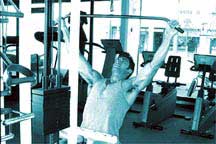
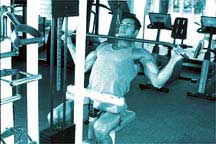
|
Wide Grip lat Pulls
This
exercise is probably the best overall movement for the back. As you pull
down the bar concentrate on feeling all the muscle's in your back contract. As you return the bar stretch upward and feel your lats
stretch.
* Muscle Confusion Tips: There are several different bars in
them. Use
them all as long as you keep your hands at least 18 inches apart to
maintain a wide grip. Change the angle of your body by leaning further
back while using a slight swinging or cheating motion. This will enable
you to use more weight. Pull to the front of your chest one workout and to
the back (behind the neck) on the next workout. |
| |
Narrow Grip lat Pulls
Perform this movement the same as the
"Wide
Grip Lat Pulls above".
* Muscle Confusion Tips: There are several different bars in the gym.
Use them all as long as you keep your hands at least 4-8 inches apart to
maintain a narrow grip. Change the angle of your body by leaning further
back and using a slight swinging or cheating motion. This will enable you
to use more weight. |
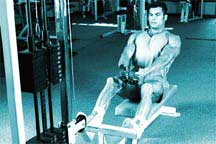
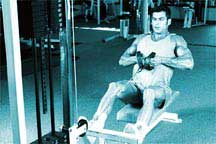
|
Seated Rows
This
is an awesome movement that will really get the top portion of your lats
burning. The photos best describe how to perform this movement. Pausing at
the start and finish will really get your blood pumping on this exercise.
As you pull the bar into chest area, be careful not to lean to far back -
this may cause injury to your lower back.
* Muscle Confusion Tips: There are several different bars in every gym.
Try them all to vary your angles and grip. By changing the width of your
grip from narrow to wide (up to 24 inches apart) you will notice a
distinct difference in the exercise. Change the angle of your body by
leaning further back and using a slight swinging or cheating motion. This
will enable you to use more weight, and you can also get a great negative
burn as you return to the starting position. |

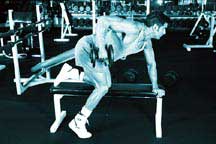
|
One
Arm Rows
Pull
the dumbbell upward towards your waist area. As you return be sure to use
the full range of motion to really stretch out the lat muscles. Lifting
straps will enable you to lift more weight. Try using them and
concentrating on the negative bum as you lower the weight.
Pauseatthetopofthelift(1-2 seconds)as you concentrate on feeling the
muscles of your inner back work to maintain the paused position.
* Muscle Confusion Tips: Try pulling the dumbbell into your,our hip
area on on one workout and into your chest area on the next workout. Reps
andvpeed are alvo an excellent way to va this exercise. Some gyms have
machines that simulate thiv motion, except you use both arms at once as if
you ",ere using a barbell. |
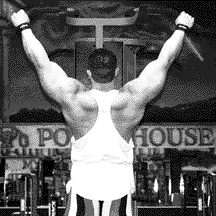
|
WideGrip Front
This classic exercise develops the lats by widening
the upper back. This variation of the classic widegrip chin behind the
neck allows a marginally greater range of motion, and marks the beginning
of Tevitaís back routine. Pull up to the top of your chest, just below the
neck. Note that the bar apparatus seen here at Powerhouse Gym/Fullerton,
has a cambered grip at each end of the bar. For variation, try using a
chin-up bar that is straight. Tevita does these a little different than
some other advanced bodybuilders: He prefers to keep his body, as seen
from the sides, fairly straight up and down. Youíll see other bodybuilders
use a significantly greater arch in their back, particularly when they
force out final reps, but Tevita prefers a stricter approach to form. |

|
Wide Grip Lat
Machine
Tevita follows wide-grip front chins with this
second upper back widener. If he were following a set scheme in which he
were doing 5 or more sets of a particular exercise, he would likely
alternate these exercises from workout to workout. But Tevita prefers 3
sets of each exercise (after warmups), running a classic 8 to 12 reps of
each, keeping pretty much the same weight through each set of the exercise. Because he does 5 different back
exercises, this gives him 15
total sets (not including warmups) for his back routine. As a highly
advanced bodybuilder, this variation in a number of exercises for the back
keeps his body constantly adapting to slight differences in approach. Note
that Tevita does have more "lean- back" when he performs this than he does
in the front chins, again providing him variety in angles and working
position. |
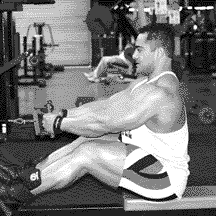
|
Seated Cable Rows
Tevita uses this exercise to increase back and
lower lat thickness. Using the standard V-bar attachment for the rowing
machine, Tevita uses a very strict approach to upper body movement: After
the weights have been drawn off the stack, Tevita uses a beginning
position for the exercise that sees his upper body only slightly bent
forward. As he contracts the back muscles, he comes only an equally small
amount "behind" fully upright. This ensures that he uses the lats, and not
lower back muscle. Remember, itís not the amount of weight you use, but
the attention to form and weight selection that makes this exercise
effective. There is a very slight arch to the back and the handle is drawn
to a center spot just below the ribcage, and a few inches above the
navel. |

|
Three Quarter
Bend
One of the more interesting variations in back
routines is this esoteric version of the full bent- over barbell row,
which thickens the upper back. Tevita does not bend fully over, but it is
essential that the barbell move directly towards the ceiling as Tevita
contracts his back muscles. Note that Tevita also uses a shorter range of
motion than most bodybuilders are accustomed to with a fully bent over
"standard" palms-in grip: He does not want this to become a bent-over
biceps curl. |

|
Straight Arm
Pull-Downs
A strict lat exercise, the straight arm pull-down
demand some attention to form: Begin with your legs slightly bent and the
bars in front of you at arms length, and at eye level. Your upper torso is
bent very slightly forward. Use the lats — not the arms or lower back — to
pull the weight down until the bar almost touches your legs. Take care in
selecting appropriate weight for this exercise. There is often a tendency
to use too much weight and lose control as the weight comes back up to the
beginning position. If you cannot maintain strict form and control the
weight as the bar returns to the original position, youíre using
too much weight. |
|
The back is
usually ignored in favor of the chest. It's a pity really, because the back is a
much larger muscle than the chest, and so would probably react more favorably to
exercise. Not to mention a V-taper always good to have! A nice thick back is
unmistakable, and makes you look more impressive in a shirt than large pecs do.
|
 |
The Irreplaceable pull-up/chin-up
The chin-up is by far the single best exercise for
the upper body. With it you can target every muscle in your back, and
other muscles as well. The key to using the chin-up to it's fullest
potential is to vary the grip and style of lift. Here's a list of some of
the variations and what areas each one targets, along with some general
tips, as usual!
- Standard, shoulder width grip, palms facing you
chin-up. This one tends to
involve the biceps a lot, so I would save this exercise till near the end of
your back workout.
- Standard, wide grip pull-up, palms facing away from you. This focuses most
of the strain on your lats, and is in my opinion crucial for building a wide
back.
- Close grip, palms facing you chin-up. This works the brachialis a lot.
- Palms facing each other, close grip pull-up. This one is done with one of
those small, triangular devices usually use on the cable row. Just hang it
over the chin-up bar, and pull yourself up so your chest touches your hands.
This exercise is great for developing the rhomboids ( down the middle of your
back).
- Palms facing each other, wide grip pull-ups. This is easiest on the
wrists, and would probably let you do the most weight/reps.
- Let yourself all the way down so that your shoulder blades go up. This
gives a full stretch, and allows for a greater range of motion.
- Pull yourself all the way up, until the bar touches your chest, or your
chin at least gets above the bar, for obvious reasons.
If you do a
combination of chin-up variations, you will find that you get a complete back
workout. There's even a good chance that your biceps will get a great workout
too.
|
 |
The Deadlift
This exercise is great for building a lot of
power,
and a really thick back. People I workout with tend to think that it's
more of a leg exercise, but if I can convince them to do 'em with me, the
next day they usually realize how wrong they were!
- Grab the bar with both palms facing you, space slightly more than shoulder
width apart.
- Always keep your back slightly arched, or at least
straight.
- legs should be about shoulder width apart.
- Lift in one smooth motion, moving your hips and back at the same time. It
may take some practice to get the motion down pat, but it's worth it. A common
mistake is to straighten your legs, then your back, or vice versa.
- Keep the bar as close to your body through the entire motion.
Unfortunately this can lead to some scraped shins which really sucks, so one
trick is to put a pad on the bar, then you can let it roll up your legs.
- Keep your shoulders back, and look straight
forward.
|
 |
Barbell rows
An obvious variation of this is the bent over
dumbbell row which allows for a greater range of motion, but I find the
bent over barbell row activates more muscle. This exercise may or may not
be necessary, depending on which variations of the chin-up you do. The
chin-up that most closely emulates the barbell row is the close grip,
palms facing each other chin-up. If you have access to a machine that lets
you rest your chest on a pad, it better isolates your back.
- Grab the bar with palms facing you, more than shoulder width
apart.
- Bend at the hips, keep your back arched, and knees
bent.
- Pull the bar up to your chest, at the bottom of the
pec.
- Vary the grip to target different regions.
- Vary the angle of your torso to target upper or middle back more.
- Keep your head up and shoulders back.
- Do full reps, letting the bar all the way down for a full stretch. It may
be necessary to stand on something elevated to achieve this, or load on a
bunch of smaller plates.
|
| |
This exercise just feels
different from barbell or dumbell rows. It feels like you can squeeze the muscle
a little more, hold the contraction a little longer. And so, I like to throw
this exercise into my routine from time to time. It's pretty straight forward:
- I prefer a to use the handle that has your palms facing each other, and
close together, though you can use pretty much any bar you want.
- Sit far back enough so you can let the weight stretch you fully before
bottoming out.
- Straighten your back and pull your hands towards your waste in one smooth
motion, not letting your back past a 90 degree angle. In other words, at the
end of the motion, your back should be straight up. Squeeze your hands into
your waste, and slowly return the weight getting a full stretch.
- For added intensity and a better stretch, you could try doing this
exercise one arm at a time.
|
A Sample back routine.
- 3-5 consecutive warm up sets of barbell rows, deadlifts, and maybe
pulldowns
- 2 working sets of wide-grip pullups, as many reps as I can.
- 2 working sets of chinups, as many reps as I can.
- 3-4 working sets of deadlifts (save it for last, cause you won't be doing
much after these!)
When you're
finished, maybe throw in a set of light
pulldowns to fully stretch your back, or just hang from a bar, and work your
wrists if you still can!
|
|
 delt -
deltoids - raise the arm to the front, side and back.
delt -
deltoids - raise the arm to the front, side and back.
 The
The
 The
The
 When
doing the
When
doing the  The
standing
The
standing 














